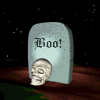
Halloween is dervived from All Hallows Eve, which originally occurs on Nov. 1st. On the Catholic Calender it is Important to observe "All Saints Day" or "All Hollows Day" because it is a time to honor the saints.
People believe that the souls of the dead would come back to earth to visit their families and friends. November 1st became known as a holy or "hallowed" day it later became known as All Hallow's Day which later evolved as what is known today as Halloween.
In Celtic Ireland during the 5th century B.C. summer officially ended on Oct. 31. It was called Samhain, which was known as the celtic New Year.
It is said that the spirits of the dead that had died that year would return to find living bodies to possess for the following year. It was known as their afterlife or Panati.
At night on October 31st, the living would extinguish fires in their homes to make them cold and undesireable. They would parade down the street in ghoulish costumes and make lots of noise to frighten away spirits.
Their are stories of Celts burning a person at the stake who was perceived to be evil or possessed, as a example to other spirits.
Human sacrifices were later abandoned by the Romans During 1st Century A.D. and were replaced by burning effigies.
Over the centuries people began not to believe so much in the supernatural, the practices sarted to become more ritualized. But people still enjoy dressin gup as ghost and withches and other ghouls.
In the 1840's Halloween traditions were brought to America by the Irish immigrants fleeing Irelands potato famine.